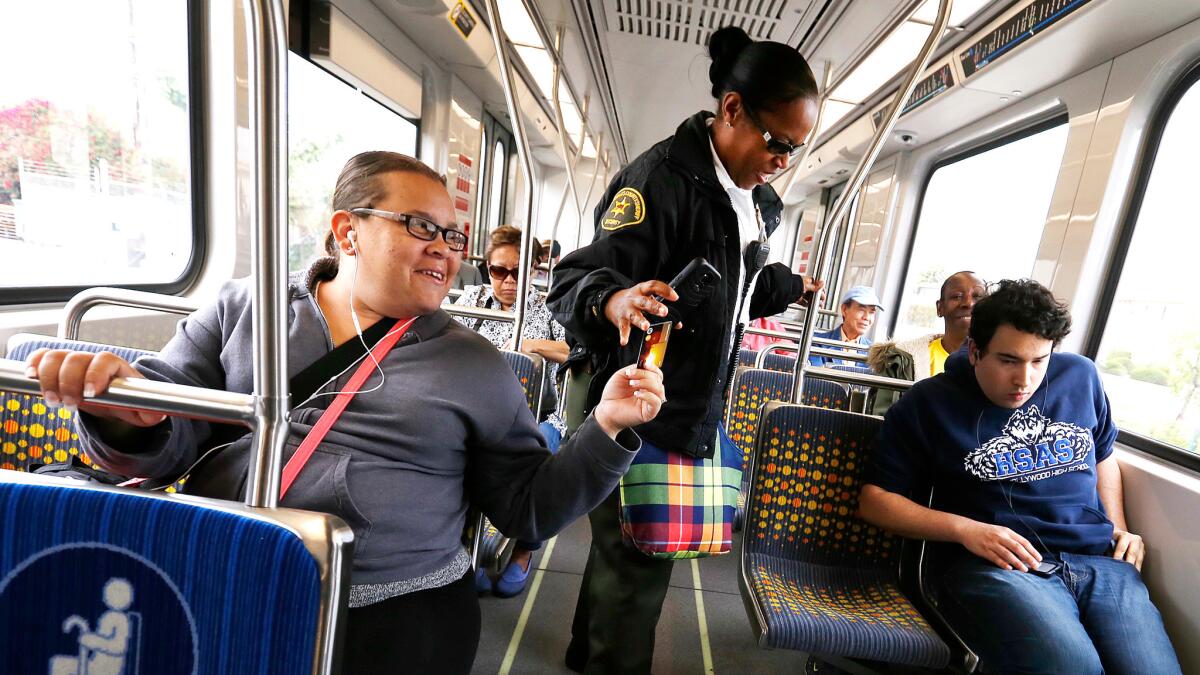Tweaks to Metro’s pass program could help more college students

- Share via
For years, securing a discounted student pass for the Los Angeles County bus and rail system has required plenty of patience.
A clunky and little-advertised application process, combined with rules that restrict part-time students from applying, may explain why just 1% of Angelenos who are going to school take advantage of discounted fares, Metropolitan Transportation Authority officials say.
“We’ve asked students to jump through a lot of hoops,” said Devon Deming, the agency’s director of commute services. “We need to make it as easy as possible for students to participate.”
See more of our top stories on Facebook >>
In a push to make the process more accessible and user-friendly, Metro’s board of directors Thursday unanimously approved a two-year pilot program that will allow students at 10 schools to sign up for transit passes when they register for classes and pay their fees.
As many as 2 million people are pursuing some form of post-high school education in Los Angeles County through four-year universities, community colleges and vocational programs, the agency estimates.
Encouraging more of them to take the bus or the train to school could help ease campuses’ parking woes and contribute to the agency’s goal of converting 20% to 25% of commuters into regular transit riders. Census data suggest that number is currently closer to 7%.
Officials say making the program more widely available will slightly ease students’ financial burdens. A monthly unlimited Metro pass costs $100 for adults, but just $43 for students.
For college students who are just starting their adult lives, Metro sees another opportunity. Introducing young people to public transportation will make them more likely to ride it when they’re older, Deming said.
“College is a great time to learn lots of new things,” Deming said. “We want riding transit to be one of them.”
Currently, students seeking discounted fares must submit their photo ID and proof of enrollment to Metro. They often wait more than a month before a special fare card arrives by mail.
Under the new process, students will immediately receive a digital sticker on their campus IDs that can be read by Metro turnstiles and fare boxes.
The agency will also reduce the number of units required to qualify for the pass, from 12 units per semester for undergraduate students to eight, and from eight units per semester for graduate students to six.
That will make 250,000 more students at public colleges eligible for benefits, Metro said. (Data from private schools are not available.)
During a meeting at Metro’s downtown headquarters, Mike Eng, a vice president of the Los Angeles Community College District Board of Trustees, told officials that three-quarters of the district’s students attend school part time and do not currently qualify for the discount.
“They’re not part-time students in the sense that they’re kicking back at their parents’ house and taking one or two classes,” Los Angeles Mayor Eric Garcetti said during the meeting. “They’re taking care of kids. They’re working. They have a whole range of challenges that they’re facing.”
How much the changes will cost isn’t yet clear, officials said, because they don’t know yet whether the program will attract people who were previously paying full price to ride; riders who are new to the system; or some of both.
Discounted student fares are funded through county sales taxes. Participating schools will have the option to further subsidize the program with their own funds, Deming said.
Students who attended the Thursday meeting said the program would ease their financial burdens and help them focus on their studies.
Others urged them to approve the program because it would open students’ eyes to seeing the region in a new way.
Jasmine Newman, a student at Los Angeles Trade Technical College, told Metro officials that she took 12 units of course work this semester in part to qualify for the subsidized transit pass.
“I ended up being stressed out and overwhelmed,” Newman said.
Taking fewer units, she said, would help with that.
For more transportation news, follow @laura_nelson on Twitter.
ALSO
Crash kills 2 in West Covina, closes westbound 10 Freeway
‘You need to come home’: Teen still missing after suspected abductor is killed in shootout
Senator calls for investigation of Purdue Pharma following Times story on Oxycontin
More to Read
Sign up for Essential California
The most important California stories and recommendations in your inbox every morning.
You may occasionally receive promotional content from the Los Angeles Times.











